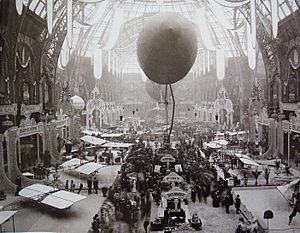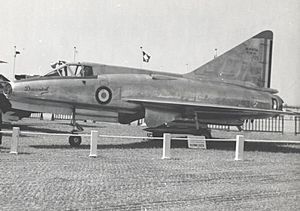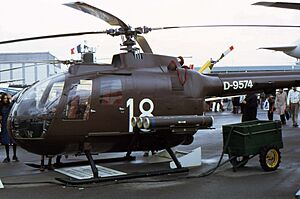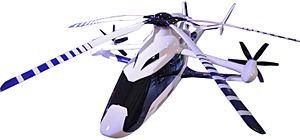Paris Air Show facts for kids
Quick facts for kids Paris Air ShowSalon international de l'aéronautique et de l'espace, Paris-Le Bourget
|
|
|---|---|
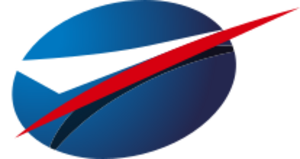 |
|

The first day of the 2007 Paris Air Show
|
|
| Status | Active |
| Genre | Commercial air show |
| Dates | June |
| Frequency | biennial: Odd years |
| Venue | Paris–Le Bourget Airport |
| Location(s) | Le Bourget, Paris (since 1953) |
| Coordinates | 48°57′20″N 2°25′57″E / 48.9555°N 2.4324°E |
| Country | France |
| Established | 1909 |
| Most recent | 2025 |
| Next event | 2026 |
| Attendance | 2017: 322000 |
| Activity | Aerobatic displays Static displays |
| Organized by | SIAE (GIFAS) |
The Paris Air Show is a huge event where the latest airplanes and space technology are shown off. It happens every two years in June at Paris–Le Bourget Airport in France. This show is organized by a French aerospace group called GIFAS. It is the biggest air show and aerospace exhibition in the world. Many countries and major aircraft makers attend, often announcing big sales.
The show starts with four days for professionals in the aviation industry. After that, it opens to the general public from Friday to Sunday. It is similar to other big air shows like the Farnborough Air Show in the UK.
| Top - 0-9 A B C D E F G H I J K L M N O P Q R S T U V W X Y Z |
History of the Paris Air Show
The Paris Air Show began in 1908 as a small part of the Paris Motor Show. The next year, in 1909, it became its own special event. It was held at the Grand Palais in Paris. About 100,000 visitors came to see new inventions from 380 companies.
The show happened a few more times before World War I. It started again in 1919 and was held every two years from 1924. After World War II, it restarted in 1946. Since 1949, it has been held every odd year.
The air show stayed at the Grand Palais for a while. From 1949, flying demonstrations were held at Paris Orly Airport. In 1953, the entire show moved to Paris–Le Bourget Airport. By the 1960s, the show was becoming famous worldwide. Since the 1970s, it has been the most important international event for the aviation industry.
Key Moments in the Show's History
1967: Rockets and New Planes
The 1967 air show was opened by French President Charles de Gaulle. He met Soviet and American astronauts. The Soviet Union showed a huge Vostok rocket, like the one that carried Yuri Gagarin into space. The American display was the largest. It featured the F-111 fighter jet and a copy of Charles Lindbergh's famous plane, the Spirit of St. Louis. A full-size model of the supersonic Concorde was also shown.
1969: Giant Jets and Spacecraft
The "largest plane in the world" at the time, the Boeing 747 jet, arrived after flying non-stop from Seattle. The Apollo 8 command module, which had been to the Moon, was also there. But the most popular exhibit was the supersonic Concorde, which flew over Paris as the show opened.
1971: Supersonic Rivals
The Soviet TU-144 supersonic airliner flew to Le Bourget for the 1971 show. People compared it to the French Concorde. The world's largest aircraft, the American Lockheed C-5 Galaxy, also landed there.
1973: A Sad Event
The 1973 show was overshadowed by the crash of the Soviet Tu-144. This accident led to stricter rules for air show demonstrations.
1975: Fighter Jet Competition
Many aircraft were shown in 1975. The American YF-16 and the French Mirage F-1E fighter jets competed in flying displays.
1989: Soviet Giants and New Moves

The 1989 show featured many aircraft from different countries. The Soviet space shuttle Buran and its huge carrier plane, the Antonov An-225 Mriya, were displayed. A Mikoyan MiG-29 jet crashed during a flight, but no one was hurt. A Sukhoi Su-27 also made its first public appearance in the West, performing a special "Cobra" maneuver.
1995: Stealth and Super Transporters
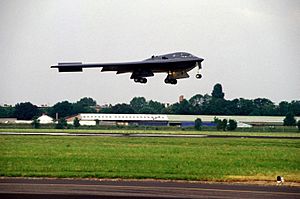
A major attraction in 1995 was the stealth B-2 Spirit bomber. Other planes included the Tupolev Tu-160 and Sukhoi Su-34 bombers. The flying display featured the Bell-Boeing V-22 tilt-rotor aircraft and the huge Airbus Beluga Super Transporter.
2001: Speed vs. Size
Boeing showed models of their Boeing Sonic Cruiser, designed to fly very fast. Meanwhile, the Airbus A380, a giant plane that seats 555 people, was on display. Crowds also toured the restored Antonov An-225 Dream, the world's largest aircraft.
2003: Farewell and Future
The Concorde F-BTSD made its last landing at Le Bourget on the opening day. Pilotless planes, like the Northrop Grumman RQ-4 Global Hawk and General Atomics Predator, also drew attention. Boeing talked about its new Boeing 787 Dreamliner.
2011: Solar Power and Big Planes
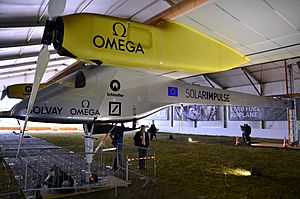
The 2011 show had over 2,100 international exhibitors and 150 aircraft. This included the Solar Impulse, a plane powered by solar energy.
2015: New Aircraft and Big Deals
The 2015 show saw the new Dassault Falcon 8X, Airbus A350 XWB, and Bombardier CS300. It attracted over 350,000 visitors and resulted in 130 billion euros in purchases. This cemented its place as the world's largest aerospace event.
2017: Many New Aircraft
The 2017 show featured 140 aircraft. Many new planes were shown for the first time, including the Airbus A321neo, Airbus A350-1000, Boeing 787-10, Boeing 737 MAX 9, and the Lockheed Martin F-35. French President Emmanuel Macron opened the show. There were announcements for 934 commercial aircraft orders.
2019: More Orders and Visitors
The 2019 show had 2,453 exhibitors and 140 aircraft. It welcomed over 316,000 unique visitors. The show ended with announcements for $140 billion worth of orders for new aircraft.
2021: Show Cancelled
The June 2021 Paris Air Show was cancelled because of the COVID-19 pandemic.
2023: The Show Returns
The air show returned in June 2023, after being cancelled in 2021. The first four days were for aviation industry professionals, followed by three days for the general public.
2025: Recent Show
The most recent show was held between June 16 and 22, 2025. The professional days were from June 16 to 19.
Accidents at the Show
Sadly, there have been a few accidents during demonstration flights at the Paris Air Show. These events are very rare, and safety rules are always being improved.
- 1961: A Convair B-58 Hustler crashed during a low-altitude aerobatics display, killing three people.
- 1965: Another Convair B-58 crashed while landing, killing the pilot.
- 1969: A Fairchild-Hiller FH-1100 helicopter crashed, killing the pilot.
- 1973: The second Tupolev Tu-144 production aircraft crashed during its display. This accident destroyed 15 houses and killed all six people on board and eight people on the ground. Many others were injured.
- 1977: An A-10 Thunderbolt II crashed, killing the pilot.
- 1989: A Mikoyan MiG-29 crashed during a demonstration flight, but no one was hurt.
- 1999: A Sukhoi Su-30 crashed during a demonstration flight, with no injuries.
See also
 In Spanish: Salón Internacional de la Aeronáutica y el Espacio de París-Le Bourget para niños
In Spanish: Salón Internacional de la Aeronáutica y el Espacio de París-Le Bourget para niños
- Farnborough International Airshow
- ILA Berlin Air Show


